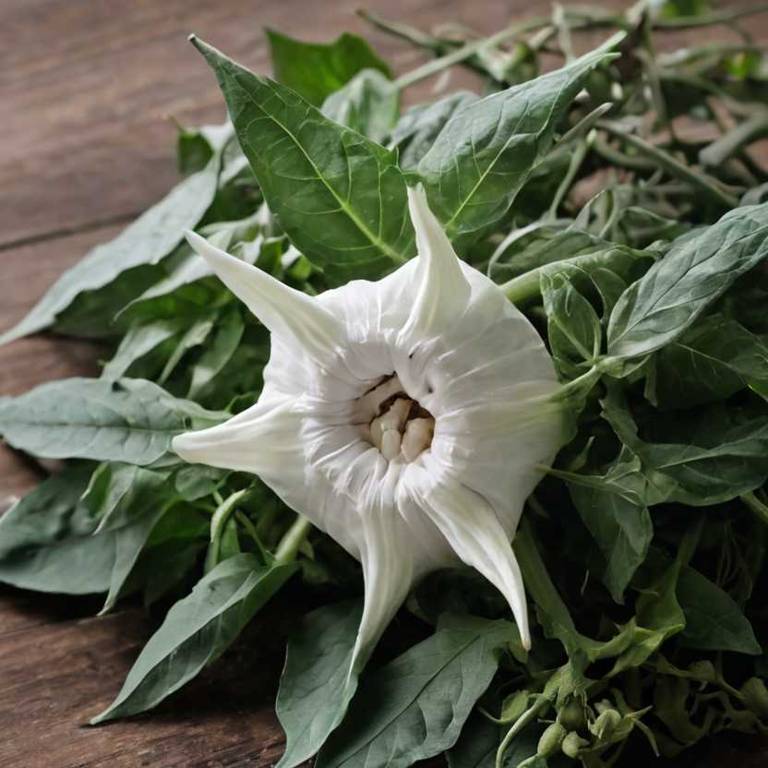By Leen Randell
Updated: Jul 06, 2024
What to know about Datura stramonium (jimsonweed) before using it medicinally

Datura stramonium, commonly known as jimsonweed, is a plant with a range of health benefits that can help improve cognitive function, alleviate anxiety and insomnia, and even exhibit antiviral properties.
As a popular ornamental plant, jimsonweed is highly valued for its striking white or purple flowers and its ability to thrive in a variety of environments. From a botanical standpoint, Datura stramonium is a member of the nightshade family (Solanaceae) and is characterized by its large, ovate leaves and distinctive, bell-shaped flowers.
Historically, the herb has been used for medicinal and ritual purposes, with ancient civilizations such as the Aztecs and Incas employing it for its perceived mystical powers and its ability to induce a trance-like state.
This article explains the medicinal, horticultural, botanical, and historical aspects of Datura stramonium.
What are the medicinal properties of Datura stramonium?
Datura stramonium helps with various health conditions, including pain management, inflammation, and respiratory issues. Its extracts have been used to treat coughs, bronchitis, and asthma. Additionally, it has been employed in traditional medicine to reduce fever and alleviate rheumatic pain.
The medicinal properties of Datura stramonium are attributed to its active constituents, including scopolamine and hyoscyamine. These tropane alkaloids possess anticholinergic and antispasmodic properties, which contribute to the plant's therapeutic effects. Scopolamine, in particular, is responsible for its sedative and antispasmodic activities.
The leaves, flowers, and seeds of Datura stramonium are commonly used for medicinal purposes. The leaves are often employed in traditional medicine to treat coughs and colds, while the seeds are used to make a tea that can help alleviate rheumatic pain and reduce fever. The flowers, rich in scopolamine, are used to treat asthma and bronchitis.
When used improperly, Datura stramonium can cause serious side effects, including hallucinations, delirium, and even death. Its anticholinergic properties can also lead to dry mouth, blurred vision, and urinary retention. Prolonged use can result in physical dependence and tolerance.
Precautions must be taken when using Datura stramonium medicinally. It is essential to consult a healthcare professional before using the plant's extracts, especially for pregnant or breastfeeding women, children, and individuals with certain medical conditions. The recommended dosage and preparation method must be carefully followed to avoid adverse reactions.
What are the horticulural aspects of Datura stramonium?
Datura stramonium grow as a herbaceous perennial in temperate climates, requiring full sun, well-drained soil, and temperatures between 65-85°F (18-30°C) to thrive.
Jimsonweed prefers well-drained, fertile soil with a pH range of 6.0-7.0, and can tolerate drought but performs better with regular watering. Sow seeds directly in spring or fall, about 1/4 inch deep, and 1-2 inches apart.
Harvest jimsonweed seeds in late fall, after they have matured and turned brown, by cutting the seed pods, allowing them to dry further, and then removing the seeds. The plant's flowers can also be harvested for medicinal and ornamental purposes.
Jimsonweed is susceptible to pests such as aphids, whiteflies, and spider mites, which can cause damage to the plant. Fungal diseases like powdery mildew and leaf spot can also affect the plant, often triggered by excess moisture and poor air circulation.
What are the botanical aspects of Datura stramonium?
Datura stramonium is a herbaceous annual plant that grows up to 1.5 meters tall, with a hollow stem and ovate leaves that are 10-30 cm long and 5-15 cm wide. The leaves are alternate, simple, and have a pointed tip.
The taxonomical classification of Datura stramonium is as follows: Kingdom: Plantae, Family: Solanaceae, Genus: Datura, and Species: D. stramonium. It is a member of the nightshade family, which also includes tomatoes, potatoes, and peppers.
Several variants of Datura stramonium have been identified, including D. s. var. stramonium and D. s. var. americana. These variants differ in their leaf shape and size. Additionally, hybrids with other Datura species have been reported.
Datura stramonium is native to the Americas and has been naturalized in many parts of the world, including Europe, Asia, Africa, and Australia. It is commonly found in disturbed areas, including roadsides, fields, and waste lands.
The life cycle of Datura stramonium is as follows: germination occurs within 10-14 days after sowing, followed by seedling establishment. The plant flowers within 30-60 days after germination and produces 10-100 seeds per capsule. The plant typically completes its life cycle within 70-120 days.
What are the historical aspects of Datura stramonium?
Datura stramonium is a plant with a long history of use in folk medicine. Indigenous peoples in North America used its seeds and leaves to treat various ailments, including fever, rheumatism, and skin conditions. European colonizers also adopted its use for similar purposes.
In mythological references, Datura stramonium is associated with the Ojibwe tribe, who believed it had healing properties for the sick. The plant is also mentioned in the mythology of the Hopi tribe, who used it in rituals to purify and cleanse. Similar associations exist in other Native American cultures.
Symbolic meanings of Datura stramonium vary across cultures. In some Native American traditions, it represents spiritual growth and transformation. In others, it's seen as a symbol of protection against evil spirits. The plant's hallucinogenic properties have also led to associations with altered states of consciousness.
Historical texts document the use of Datura stramonium by early European settlers in North America. For example, English colonist John Smith wrote about the plant's use in treating fever and rheumatism in his book "The Generall Historie of Virginia, New-England, and the Summer Isles" (1624). Similarly, French naturalist Jean-Baptiste Lamarck mentioned its use in his book "Encyclopédie Méthodique" (1783-1822).
Historical artifacts associated with Datura stramonium include ceramics, textiles, and other objects created by Native American artists, which feature the plant in designs and motifs. Examples can be found in museums, such as the Smithsonian Institution, which houses collections related to the plant's use in Native American cultures.